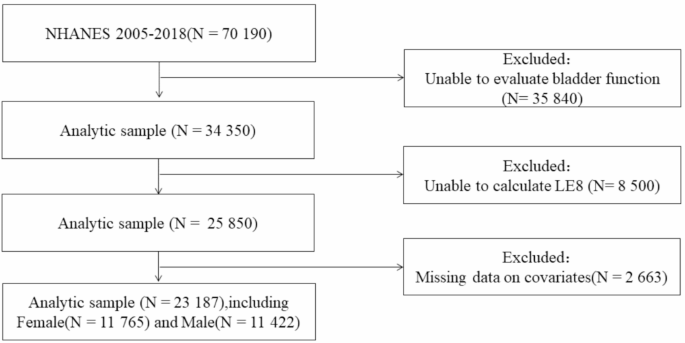This study demonstrates an inverse association between LE8 score, a composite metric of cardiovascular health, and risk of OAB10. Higher LE8 scores were associated with progressively lower odds of OAB in a dose-response manner11. This relationship persisted in multivariate regression models adjusting for potential demographic and socioeconomic confounders, suggesting it is independent of these factors.
WQS regression further identified blood glucose, BMI, nicotine exposure, BP and sleep health as the key LE8 components contributing to its inverse link with OAB. Of these, blood glucose exhibited the strongest individual association, aligning with prior evidence that diabetes can result in bladder dysfunction6. Taken together, these findings indicate that improving LE8 metrics may confer protective effects against OAB susceptibility12. This highlights novel opportunities for lifestyle-based OAB prevention strategies by targeting optimization of cardiovascular health factors13.
Among the top LE8 metrics, many diabetic metabolites (e.g. monosodium urate, HMGB1, etc.) can trigger bladder inflammation and overactive bladder by activating NLRP3 inflammatory vesicles in the urine epithelium5,6. Excess weight predisposes to OAB potentially via direct pressure effects on the bladder and neuropathy associated with metabolic conditions14. Nicotine can elicit lower urinary tract symptoms (LUTS) through decreased bladder blood flow and uroepithelial hypoxia15,16, Optimal blood pressure control reduces risk of bladder ischemia and oxidative stress that can precipitate detrusor overactivity13. Finally, adequate sleep optimizes hormonal balance and neural pathways regulating urination, whereas sleep deprivation has been linked to overactivity of bladder afferent pathways17. Elucidating these mechanisms provides biological plausibility linking LE8 components to lower OAB susceptibility.
This study reveals an important link between cardiovascular health as measured by LE8 and susceptibility to overactive bladder syndrome18. The findings have significant public health implications in illuminating lifestyle optimization as a promising strategy for OAB prevention. Improving diet quality, increasing physical activity, achieving healthy weight status, and optimizing sleep, cholesterol, BP and glucose levels may confer collateral benefits for bladder health14. Population-level interventions targeting LE8 metrics could potentially help curb the rising tide of OAB and related healthcare burden.
On an individual patient level, the results provide a rationale for clinicians to consider LE8 status in OAB risk assessment and counsel patients on lifestyle changes for better bladder control12. This represents a shift from compartmentalized care focusing only on the bladder, towards whole-person preventive health19. Realizing such integrated care models will require cross-disciplinary collaboration between urologists, primary care providers, and other specialists20.
Ultimately, research on LE8 scores helps move the field towards prevention-oriented management21. Further studies elucidating lifestyle, behavioral and cardiovascular factors influencing OAB susceptibility will be instrumental in this paradigm shift22.
This study has several innovative aspects advancing our understanding of modifiable OAB risk factors. First, it represents the first analysis linking the novel LE8 cardiovascular health score, representing a constellation of lifestyle, clinical and biological factors, to OAB susceptibility23. This moves beyond conventional risk factors to a more integrated metric encompassing overall wellbeing. Second, the use of robust statistical techniques including RCS and WQS regression provides rigorous delineation of the relationship between LE8 and OAB. The dose-response curve and identification of key LE8 drivers are significant methodological strengths.Third, the dissection of individual contributions of LE8 components is highly innovative, revealing glycemic control as the most impactful element5. This granular analysis of a composite risk metric is novel in the OAB literature and generates actionable insights for targeted preventive approaches12. Overall, the analytical strategies overcome limitations of previous observational research and provide high-quality evidence to motivate lifestyle optimization for maintaining bladder health19. This study exemplifies the type of innovative methodology required to advance our understanding of modifiable determinants of OAB21.
This study has certain limitations intrinsic to cross-sectional analyses that warrant acknowledgement. First, the cross-sectional design precludes causal inference, and reverse causation remains possible if OAB leads to decreased physical activity and subsequent worsening of LE8 metrics24. To establish temporality, large-scale longitudinal cohorts tracking LE8 status and onset of OAB over time are needed25. Second, self-reported data on OAB symptoms and LE8 components like diet and exercise carries potential for recall bias. However, NHANES uses well-validated instruments administered by trained staff to maximize accuracy26. Third, using a composite of multiple predictors to define a multifactorial syndrome like OAB can complicate result interpretation. Our goal was to explore how integrating diverse factors could provide a more comprehensive understanding of OAB. Additionally, we employed Weighted Quantile Sum (WQS) regression to assess the individual contributions of these factors, aiming to generate actionable insights for real-world application. We anticipate further research to refine and enhance its broader implementation. Finally, one-time assessment of LE8 may not fully reflect long-term exposure to poor cardiovascular health markers, which would be better captured through repeated measurements27.
This research motivates several fruitful avenues for future investigation. Longitudinal cohort studies tracking LE8 status over years or decades could elucidate whether optimal cardiovascular health metrics assessed earlier in life predict lower OAB incidence with aging. Large, multi-center trials are needed to determine if lifestyle interventions targeting LE8 improvement can reduce downstream OAB risk28. Studies in more diverse populations can evaluate generalizability of associations across racial/ethnic groups. Finally, research on pathologic mechanisms is warranted to explain observed epidemiological links between cardiovascular health metrics and OAB susceptibility21.


